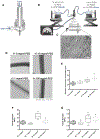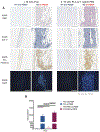Bioactive proteins delivery through core-shell nanofibers for meniscal tissue regeneration
- PMID: 31493556
- PMCID: PMC6911641
- DOI: 10.1016/j.nano.2019.102090
Bioactive proteins delivery through core-shell nanofibers for meniscal tissue regeneration
Abstract
Mimicking the ultrastructural morphology of the meniscus with nanofiber scaffolds, coupled with controlled growth-factor delivery to the appropriate cells, can help engineer tissue with the potential to grow, mature, and regenerate after in vivo implantation. We electrospun nanofibers encapsulating platelet-derived growth factor (PDGF-BB), which is a potent mitogen and chemoattractant in a core of serum albumin contained within a shell of polylactic acid. We controlled the local PDGF-BB release by adding water-soluble polyethylene glycol to the polylactic acid shell to serve as a porogen. The novel core-shell nanofibers generated 3D scaffolds with an interconnected macroporous structure, with appropriate mechanical properties and with high cell compatibility. Incorporating PDGF-BB increased cell viability, proliferation, and infiltration, and upregulated key genes involved in meniscal extracellular matrix synthesis in human meniscal and synovial cells. Our results support proof of concept that these core-shell nanofibers can create a cell-favorable nanoenvironment and can serve as a system for sustained release of bioactive factors.
Keywords: Co-axial electrospinning; Core-shell structure; Meniscus; Nanofibers; PDGF-BB; Tissue engineering.
Copyright © 2019 Elsevier Inc. All rights reserved.
Conflict of interest statement
Figures







Similar articles
-
Core-Shell Nanofibrous Scaffolds for Repair of Meniscus Tears.Tissue Eng Part A. 2019 Dec;25(23-24):1577-1590. doi: 10.1089/ten.TEA.2018.0319. Epub 2019 Aug 14. Tissue Eng Part A. 2019. PMID: 30950316 Free PMC article.
-
Collagen fibrous scaffolds for sustained delivery of growth factors for meniscal tissue engineering.Nanomedicine (Lond). 2022 Jan;17(2):77-93. doi: 10.2217/nnm-2021-0313. Epub 2022 Jan 7. Nanomedicine (Lond). 2022. PMID: 34991339 Free PMC article.
-
Fabrication and Characterization of Core-Shell Nanofibers Using a Next-Generation Airbrush for Biomedical Applications.ACS Appl Mater Interfaces. 2018 Dec 12;10(49):41924-41934. doi: 10.1021/acsami.8b13809. Epub 2018 Nov 28. ACS Appl Mater Interfaces. 2018. PMID: 30433758
-
Meniscal tissue repair with nanofibers: future perspectives.Nanomedicine (Lond). 2020 Oct;15(25):2517-2538. doi: 10.2217/nnm-2020-0183. Epub 2020 Sep 25. Nanomedicine (Lond). 2020. PMID: 32975146 Review.
-
Advances in electrospun scaffolds for meniscus tissue engineering and regeneration.J Biomed Mater Res B Appl Biomater. 2022 Apr;110(4):923-949. doi: 10.1002/jbm.b.34952. Epub 2021 Oct 7. J Biomed Mater Res B Appl Biomater. 2022. PMID: 34619021 Review.
Cited by
-
Smart ECM-Based Electrospun Biomaterials for Skeletal Muscle Regeneration.Nanomaterials (Basel). 2020 Sep 9;10(9):1781. doi: 10.3390/nano10091781. Nanomaterials (Basel). 2020. PMID: 32916791 Free PMC article. Review.
-
Electrospun core-shell nanofibers with encapsulated enamel matrix derivative for guided periodontal tissue regeneration.Dent Mater J. 2021 Sep 30;40(5):1208-1216. doi: 10.4012/dmj.2020-412. Epub 2021 Jun 12. Dent Mater J. 2021. PMID: 34121026 Free PMC article.
-
Pneumatospinning Biomimetic Scaffolds for Meniscus Tissue Engineering.Front Bioeng Biotechnol. 2022 Feb 2;10:810705. doi: 10.3389/fbioe.2022.810705. eCollection 2022. Front Bioeng Biotechnol. 2022. PMID: 35186903 Free PMC article.
-
Biomaterials and Meniscal Lesions: Current Concepts and Future Perspective.Pharmaceutics. 2021 Nov 7;13(11):1886. doi: 10.3390/pharmaceutics13111886. Pharmaceutics. 2021. PMID: 34834301 Free PMC article. Review.
-
Electrospun Nano-Fibers for Biomedical and Tissue Engineering Applications: A Comprehensive Review.Materials (Basel). 2020 May 6;13(9):2153. doi: 10.3390/ma13092153. Materials (Basel). 2020. PMID: 32384813 Free PMC article. Review.
References
-
- Hickey DS, Hukins DW. Relation between the structure of the annulus fibrosus and the function and failure of the intervertebral disc. Spine (Phila Pa 1976) 1980;5:106–16. - PubMed
Publication types
MeSH terms
Substances
Grants and funding
LinkOut - more resources
Full Text Sources

